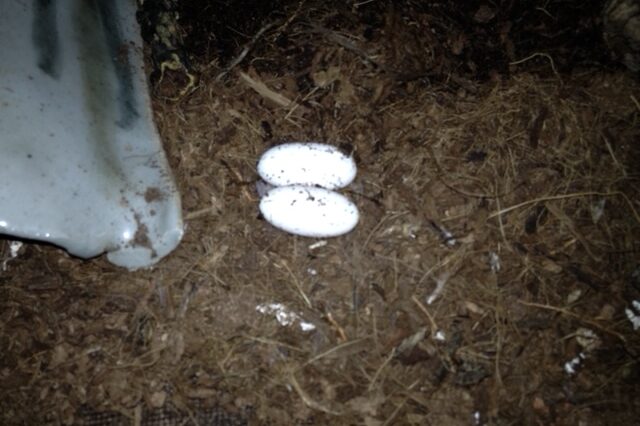breeding
Latest stories
More stories
-
640 Views6 Comments
in Featured ArticlesGecko Time 10th Anniversary!
Gecko Time online magazine published its first articleon March 7, 2009. During the past 10 years, Gecko Time has been an important resource to the gecko community with the wide range of articles it has published. Articles have included interviews, DIY instructions, product reviews, species and genus profiles, genetics information as well as many other topics.
Ten years is a long time, and is more than half a lifetime for some of our younger gecko keepers. More -
2.1k Views2 Comments
in Featured ArticlesCrested Gecko Breeding Revisited
Let’s talk a little about Crested Gecko breeding. Many new breeders or hobbyists in the Crested Gecko world will simply put any male and female together, just hoping to produce babies. There’s no rhyme or reason to the pairings and the results are generally a mix of whatever morphs are being paired. More
-
801 Views
in Featured ArticlesGecko Time Wants to Know: African Fat Tail Geckos
For many years it seemed as if African Fat Tail geckos were simply drab cousins of the much more popular leopard geckos. With the advent of new morphs such as whiteout, zulu and oreo, the fat tail palette colors and patterns has exploded and their popularity has soared. Despite this, it was very difficult to find people willing and able to answer some of Gecko Time’s questions about them.
More -
2.9k Views1 Comment
in Featured ArticlesThe Art of Raising Feeder Insects
Are you considering raising multiple types of feeders? There are a few things you need to think about before trying to make sure you can provide all that the feeders need. Space is incredibly important; certain species will not only need different types of cages but different sizes as well. More
-
891 Views2 Comments
in Featured ArticlesHow to Sell Your Geckos Revisited
In 2010 I wrote an article How to Sell Your Geckos in order to provide suggestions about venues for selling as well as recommendations for how sellers should approach the whole concept of selling an animal to someone as a pet. The contents of the article are still relevant, but the information needs to be updated due to two relatively recent developments: the increase in gecko breeders and the explosion of social media options. More
-
825 Views1 Comment
in Featured ArticlesGecko Time Wants to Know: Crested Geckos
Crested geckos have been available in the hobby, not to mention in the annals of herpetologists, for slightly more than 20 years. Almost since they were introduced, crested geckos have exploded in popularity due to how easy it is to care for and breed them. Here is what three respected crested gecko breeders have to say about crested gecko genetics, breeding, housing and sales. More
-
2.7k Views3 Comments
in Featured ArticlesGecko Time Wants to Know: Leopard Geckos
This is the first in a new monthly series at Gecko Time. Thinking well beyond the basic care issues for popular gecko species, Gecko Time is interested in hearing from established breeders about more advanced topics such as market trends, issues unique to the particular species and long term breeding considerations. Each month, Gecko Time will put three questions to established breeders of a gecko species to get their thoughts on these issues. More
-
4.4k Views7 Comments
in Featured ArticlesNoir Désir – The New Recessive Trait with Leopard Geckos
It all started in 2013 when I was frantically looking for a nice tangerine male to improve my tangerine line. Despite knowing a lot of world known breeders I hadn’t found what I was looking for and my dearest friend and partner Lydie Verger -Didiegecko Aft, kindly offered me one of her hatchlings, a really nice looking Mandarin Tangerine male named Noir Désir (meaning Black Desire in French). This male hatched out of superb looking Mandarin Tangerine pairing with practically full Carrot Tails. It was very visible that this male, Noir Désir, had the same qualities as its parents but a different, much darker overall look. More
-
2.8k Views12 Comments
in Featured ArticlesNotes on Crested Gecko Genetics
The genetics of Crested Geckos (Correlophus ciliatus), in contrast to that of other popular reptile breeding subjects, such as leopard geckos or ball pythons, has not yet been well understood or documented. They appear to exhibit multiple allelism, having multiple phenotypes for the natural selection phenomenon to work on. This may be an advantage to the species as there are many different traits that can be expressed, which lends itself to having more chances of adaptation and survival through generations. More
-
405 Views1 Comment
in Featured ArticlesInterview with Brian Barczyk of BHB Reptiles
Today we interview Brian Barczyk of BHB Reptiles. Although Brian works prominently with snakes, he has strong passion for all animals. Brian also produces snakebytes.tv, a Youtube show for reptile lovers. More
-
356 Views3 Comments
in Featured ArticlesShould We Breed Popular Gecko Species? Yes!
Keeping reptiles is a rewarding experience, one that develops a bond with these animals. Consequently, we find ourselves asking questions and raising issues rooted in morality and ethics. One such question has been surfacing lately regarding the continued breeding of some of the most popular species such as crested geckos (Correlophus ciliatus), gargoyle geckos (Rhacodactylus auriculatus), and especially leopard geckos (Eublepharis macularius). More
-
6k Views4 Comments
in Featured ArticlesKeeping Genus Tropiocolotes
The term ‘micro gecko’ can refer to members of the genus Tropiocolotes. The two species that I keep are Tropiocolotes tripolitanus and T. steudneri. These are a couple of the most common species of micro geckos available in the industry. Many are imported as wild caught adults, however small numbers of captive bred young are produced each year. More




